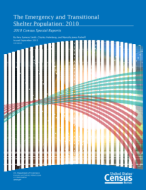The Emergency and Transitional Shelter Population: 2010
The Emergency and Transitional Shelter Population: 2010
Introduction
Studying the population in emergency and transitional shelters for people experiencing homelessness provides information about one segment of the group quarters population in the United States. This special report focuses on the 209,000 people enumerated in the 2010 Census at emergency and transitional shelters and their demographic characteristics and geographic distribution. Although this population accounted for only 2.6 percent of the nearly 8 million people in group quarters, examining this group provides information on the portion of the population experiencing homelessness that is valuable to federal, state, and local agencies for a variety of reasons such as program planning and implementation.
Definition of Emergency and Transitional Shelters
In the 2010 Census, emergency and transitional shelters (i.e., shelters with sleeping facilities) for people experiencing homelessness were defined as places where people experiencing homelessness stay overnight. Examples include missions; hotels and motels used to shelter people experiencing homelessness; shelters for children who are runaways, neglected, or experiencing homelessness; and similar places known to shelter people experiencing homelessness. Descriptions of emergency and transitional shelters include:
• Shelters that operate on a firstcome, first-serve basis where people must leave in the morning and have no guarantee of a bed for the next night.
• Shelters where people know that they have a bed for a specified period of time (even if they leave the building every day).
• Shelters that provide temporary shelter during extremely cold weather (such as churches).
This category does not include shelters that operate only in the event of a natural disaster.
The emergency and transitional shelter population is one of many types that make up the total group quarters population. For more details about the group quarters population, see Appendix B in the 2010 Census Summary File 1, technical documentation available at <www.census.gov/prod/cen2010/doc/sf1.pdf>.
Others in Series
Publication
Publication
Publication




